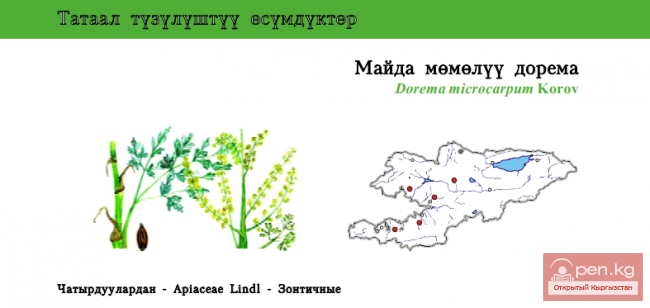
Eremurus zoae Status: VU. A narrowly endemic species of the Kyrgyz Range....

Kostychev’s Pascueflower Status: VU. A narrowly endemic and very beautiful plant, deserving...

Knorring’s Haw-tree Status: VU. A narrowly endemic species....

Schennikov’s Otostegia Status: VU. A rare endemic species, endemic to Kyrgyzstan with a disjunct...

Pskem Onion Status: EN. A very rare species with a shrinking range in the Western Tien Shan....

Golden Trichanthemis Centaury Status: VU. A rare narrowly endemic species of the Alai Ridge, an...

Eremurus Zenaidae Status: VU. Endemic to the lower and middle belts of the Fergana and Alai...

Kaufmannia Semenova Status: VU. Endemic, rare species....

Anomalous Alajja (Erianthera anomala) Status: VU. Endemic to the mountains of Central Asia. A rare...

Kolpakovski’s Tulip Status: VU. An endemic of the Northern Tien Shan with a decreasing population....

Related Tulip Status: VU. Endemic species of the northern Pamir-Alai. The species is at risk of...

Acantholimon compactum Status: VU. A very rare narrowly endemic species....

Semenov’s Onion Status: VU. Endemic to the Inner Tien Shan....

Quadrifolious Tulip Status: VU. Endemic to the Inner Tien Shan....

Broad-stamened Tulip Status: VU. A narrow endemic of the Alai Ridge....

Dwarf Ammopiptanth Status: EN. A rare species with a disjunctive range. One of two known...

Kashgarian Bean Caper Status: VU. Rare, little-studied endemic species....

Lepidolopha Komarovii Status: EN. An endemic species of mountainous Central Asia, representative...

Twelve-dentate Onion Status: VU. A narrowly endemic species of the Chatkal Ridge. Description. A...

Chatkal Yellow Tulip Status: VU. An endemic species of the Chatkal Ridge with a decreasing...

Kosopoljanskaya Turkestanian Status: VU. One of the two endemic species of this genus found in...

Wolly-fruited Kosopoljanskia Status: EN. Endemic. One of the two species that are sub-endemic to...

Vvedensky’s Sage Status: VU. A very rare narrowly endemic species. An ornamental plant....

Alai Bubblewort Status: VU. A rare narrowly endemic species....

Iridodictyum Kolpakovski Status: VU. A species with a reducing range and population. It deserves...

Korolkov’s Tulip, shiny Status: VU. Endemic to Central Asia, primarily found in Uzbekistan and...

Susamyr Catchfly Status: EN. A rare species found in small numbers and in a limited area, which...

Large-calyxed Primrose Status: VU. In Kyrgyzstan, it is a very narrowly distributed, rare,...

Tianschaniella umbellifera Status: VU. A significantly declining narrowly endemic species of...

Kaufmann’s Tulip Status: VU. An endemic species of the Western Tien Shan. Highly decorative: the...

Hairy Flowering Plant Aulie-Ata Status: EN. A representative of a monotypic section, a narrowly...

Wrapped Alpine Saw-wort Status: VU. Rare species. Found in Kyrgyzstan at the edge of its range....

Petunnikov’s Almond Status: VU. One of 40 species growing from the Mediterranean to Central Asia....

Eugenia’s Bell-flower Status: VU. Endemic to the Western Tien Shan (Talas and Fergana Ranges). A...

Dorema microcarpum Status: VU. Rare endemic species....

Uzun-Akhmat Grape Status: VU. Endemic species of Western Tien Shan....

Regel’s Eminium Status: VU. A rare endemic species of the Western Tien Shan....

Paradoxical Honeysuckle Status: Category CR B2ab(iii). A relict endemic species with a disjunctive...

Catmint-like Scullcup Status: VU. A very rare narrowly endemic species. Ornamental plant....

Intermediate Hyalolaena Status: VU. Endemic. One of three species growing in Kyrgyzstan....

html Lamyropappus schakaptaricus Status: VU. A rare representative of a monotypic genus....

Olga’s Sorbaria Status: CR B2ab(iii). A rare narrow-endemic species of the Alai Mountain Range....

All elements and conditions, as well as phenomena and bodies of nature, can be used in public...